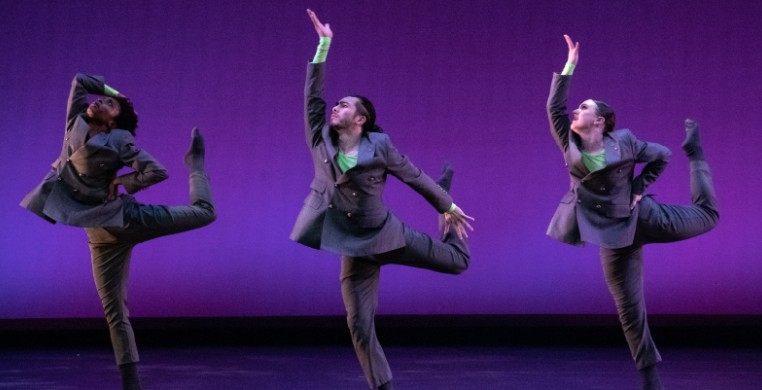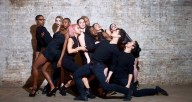UPDATE: The new seechicagodance.com will launch March 31st. Click here to learn more.
Review: South Chicago Dance Theatre celebrates their 5th Anniversary with an evening of new work by some of Chicago’s top choreographers
On Friday, May 20th, South Chicago Dance Theatre (SDCT) celebrated their fifth anniversary with an evening of dancing, presenting five new commissions by choreographers with strong ties to decades of Chicago dance. Despite being founded only five years ago, SCDT has grown into a nationally and internationally touring dance company that sponsors and promotes several programs for mentorship (e.g., the company’s Emerging Artist Program) and education (e.g., the annual South Chicago Dance Festival). In a program note, founder and executive director Kia S. Smith affirms that, despite their growth, that SCDT is still committed to its founding principles, writing that, “In the pursuit of diversity and equity, this evening of dance hopes to illuminate perspectives of the human experience through the lens of black and brown choreographic voices while commemorating SCDT’s first five years of existence.”
The evening began with “Coéurs Separés,” a work by Wade Schaaf, set to a quickly moving, baroque-style composition for piano by Bach. A ballerina dressed in a flesh-colored top and long, red dress performs chaotic spins and leaps while trapped in a small box of light. She is soon joined by two more, also trapped in boxes, and then more, until the stage is filled with dancers, struggling like fireflies trapped inside individual glass jars. The movement is explosive but refined. Simultaneously, everyone swings their arms up. The momentum carries their bodies into the air, a crescent leap. On the way back down, one arm corkscrews around their heads as they softly land. Towards the end, a saltatorial trio comprised of guest artist Mauricio Fernandez and company members Elijah Richardson and Kim Davis perform intricate patterns of continuous interaction: the spinning head of one connects with the spinning head of another, who then spins out and connects with the third, causing that person to fall to the ground dramatically, their landing creating shockwaves that stun the others. Schaaf’s choreographic style and overlapping transitions remind me of a fireworks display, but in “Coéurs Separés,” it feels more like a heap of loose flower petals being blown around on a windy summer day.
Smith’s “In Lieu of Flowers” is a compact duet between company member Kelly Anderson and guest artist Taylor Yocum that explores how dominance is leveraged in any relationship. Anderson and Yocum, appearing in sand-colored, short-sleeved tops and snug black pants, are followed by a roaming spotlight. At the start, Yocum, as if possessed, tumbles to the ground and contorts into various shapes, while Anderson waves her arms around like a wizard casting a spell, clearly the dominant one. Soon the tone changes and it feels as if we are skipping through time, fast-forwarding to moments of their lives, then hitting “play” to view them in slow motion. Sometimes they fight by throwing and dodging punches. There is a scene where they are deciding what to buy in a store as they compare imaginary objects. A recurring sassy swivel in the hips during Motown-like musical “shoo-bop, shoo-bop” makes me smile, but also makes me wonder: Where in the timeline was the bleak beginning; and, if a preclusion, what brought them to such a dower point?
“On a Lark” by Stephanie Martinez is an ode to the days of musical comedy, when “cheese” and “personality” helped shape the aesthetic of what we now consider to be “classic Broadway.” Martinez reduces the saccharine quality of the acting by including moments reminiscent of those “dream ballets” conceived by the like of Kelly and DeMille in the 1940s and ‘50s. The soundtrack is a potpourri of early Disney and Hollywood-jazz standards from the 1940-70, and there are the occasional vernacular jazz dance steps scattered throughout the piece, like leg-crossing “grapevines” and World War I-inspired “In the Trenches.” In a short solo, Richardson embodies a “drunk” Donald O’Connor, landing a flying tour jeté into a cocky, rubber-legged strut, arms akimbo, shoulders pumping in alternation; guest artist Ricky Ruiz is the broad-chested Gene Kelly-type who seems to “gotta dance” by performing large leaps, a sense of humor on his face, while an ominous clanging in the music seems to signal some world-ending catastrophe. Later, a duo comprised of Richardson and Yocum perform a lyrical duet to “Moon River.” On the lyric “two drifters, off to see the world,” Yocum leaps, arm outstretched, only to be halted, then cradled, by Richardson, who gently drifts her away, as if to remind her to pace herself—there is “such a lot of world to see,” after all.
“Lit-Anies” by Crystal Michelle Perkins has dancers in white pants and tank tops performing close to the floor against a sorrowful gospel spiritual. There are several allusions to an Earth connection. Some of them drop to their knees and worrisomely gather some imaginary material. Others put their ears to the ground in anticipation of something big approaching. The dancers stay low, like when a trio of women perform round kicks from a crouch while spinning, then diving into a plank position, palms flat on the floor, legs kicking out. The piece ends as the dancers slowly walk backwards against a dark blue background, a voiceover reciting a doleful, yet optimistic, aphorism: “what I leave behind has a life of its own,” a good example of the juxtaposition of joy and sorrow found in gospel music embodied into movement.
The program concludes with “HYbr: ID Line” by Ron De Jesus, a high-energy work set to a metallic and industrial soundtrack. Dressed in black jumpsuits with a long slit up the side, dancers perform small movements that grow into big explosions. A tight, 10-person phalanx holds their elbows at right angles, then sends that tension into their fingertips, curling them upward. Then a release, their bodies drooping into a low, hanging sway. And then… run! The soundtrack switches to the syncopated sounds of grinding and clanging factory machines while Davis runs and performs a half-flip, being caught upside-down and in midair by Richardson, who flips her around and sends her running away in a cheetah-like gallop. “HYbr: ID Line” sets itself apart from the other works in the program by choosing to ignore subtleties, like narrative and introspection, focusing instead on sharp and athletic movements performed in succinct and cohesive groups.
The program had a relatively small company of dancers performing demanding works in succession with no drop in quality or hint of fatigue. Their stamina was impressive, but not surprising. This work ethic is emblematic of the company itself. In only five short years, Smith and SCDT have built up an impressive string of top-notch performances, several outreach and educational programs and have gathered an impressive repertoire of work—just imagine where they will be in another five years! Whatever direction the company takes, I’m looking forward to it.


